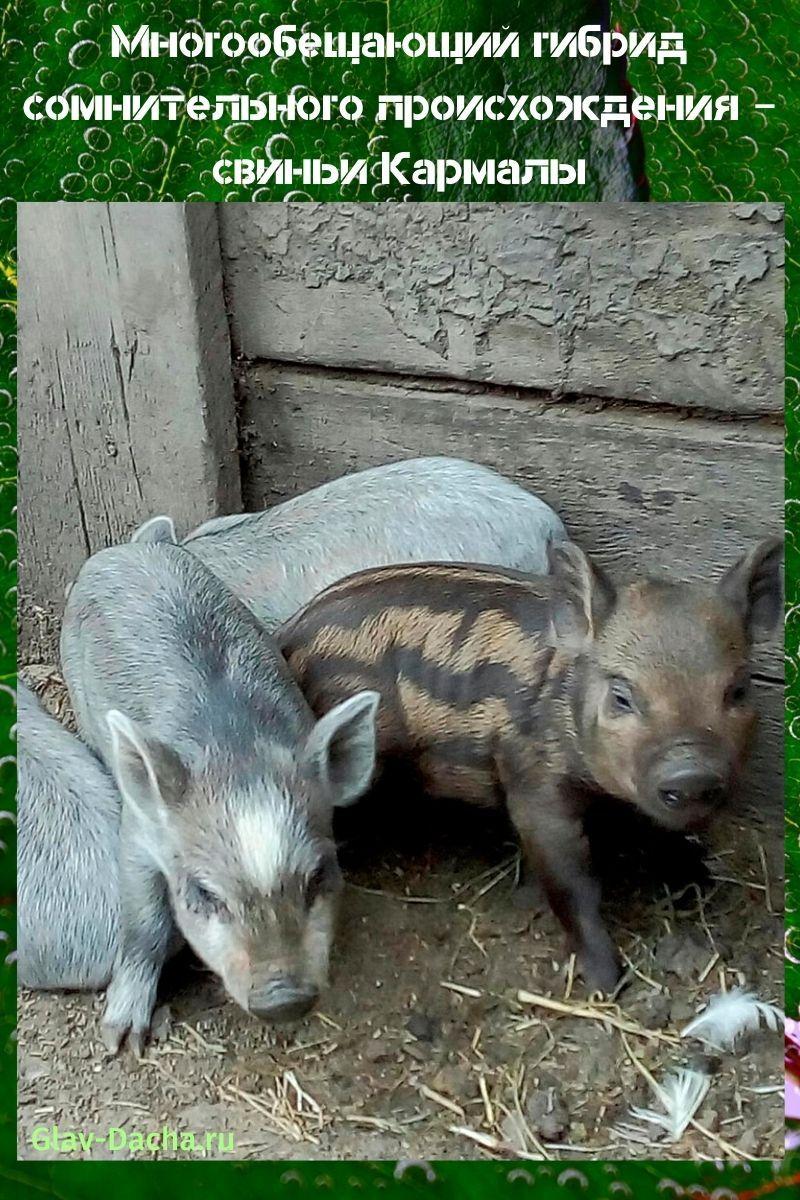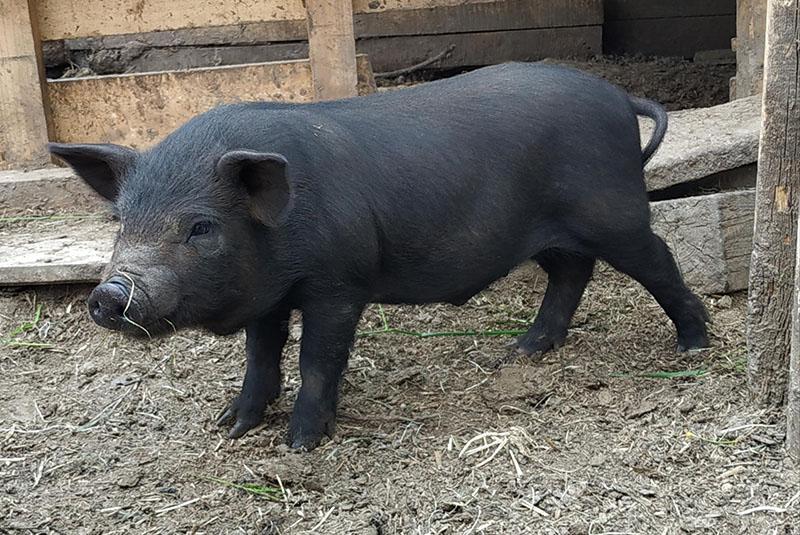A promising hybrid of dubious origins - the Karmala pig
 It is unlikely that any other breed is now causing such lively controversy as the karmaly pigs. Piglets are asking for fabulous sums, and sellers are vying with each other to extol the extraordinary qualities of this breed that does not exist today. Let's try to figure out if karmal pigs are really that good and whether it is worth breeding them.
It is unlikely that any other breed is now causing such lively controversy as the karmaly pigs. Piglets are asking for fabulous sums, and sellers are vying with each other to extol the extraordinary qualities of this breed that does not exist today. Let's try to figure out if karmal pigs are really that good and whether it is worth breeding them.
Conflicting origins

Additional confusion about the origin of karmales is caused by the following points:
- the Vietnamese pot-bellied and Korean herbivorous pigs are very similar and it is difficult for a layman to determine the breed correctly;
- farms contain a huge number of a wide variety of crosses of European and Asian breeds;
- Many pig breeders call the descendants of the Vietnamese pot-bellied pigs "mangal", and not the male downy mangalitsa, which adds even more confusion when trying to understand the pedigree of karmal piglets.
Experts believe that the piglets that are offered for sale under the guise of "ordinary karmales" are descendants of Asian breeds or their crosses. Asian roots are clearly visible in the photo of karmal pigs - thick dark fur, back with a sag, sagging belly and an elongated body with short legs.
In addition to "ordinary karmales", so-called "royal karmales" are found in advertisements for the sale of "thoroughbred young". Judging by the long wavy bristles, the royal karals are the descendants of the crossing of ordinary with Hungarian mangalits.
It is very risky to take piglets of such dubious origin for fattening and breeding. The descendants of such inbreeding may not inherit parental traits, and closely related crossbreeding is always fraught with the appearance of deformities and other undesirable qualities.
Description of the karmal pig breed
 Pig breeders are enthusiastic about the characteristics of the Karmal pigs. According to them, the pets inherited the best properties of their Hungarian and Asian ancestors. Like the Hungarian mangalitsa, karals have a dense coat that allows free pasturing all year round. From pot-bellied and herbivorous "Asians" they adopted a healthy maternal instinct, abundance, friendly disposition and quick weight gain on juicy green forages.
Pig breeders are enthusiastic about the characteristics of the Karmal pigs. According to them, the pets inherited the best properties of their Hungarian and Asian ancestors. Like the Hungarian mangalitsa, karals have a dense coat that allows free pasturing all year round. From pot-bellied and herbivorous "Asians" they adopted a healthy maternal instinct, abundance, friendly disposition and quick weight gain on juicy green forages.
According to the descriptions of pig farmers, karmalas represent an ideal pig with excellent qualities such as:
- omnivorous;
- good health and frost resistance;
- good immunity;
- peaceful character;
- multiplicity;
- rapid puberty;
- the possibility of subsequent fertilization one month after farrowing;
- a small percentage of fat in meat.
The exterior reflects a whimsical blend of European and Asian roots:
- short head of medium size;
- short wide neck;
- large short snout;
- White skin;
- the body is short, barrel-shaped;
- back without pronounced deflection;
- slightly sagging belly;
- short strong legs.
The animals have an elongated coat with a thick brown, black or gray undercoat. Sometimes there are red, striped or spotted individuals.
Pigs almost do not differ in weight from boars. The weight of an adult pig is 190-230 kg.
Recommendations for care and breeding
 Thanks to the thick coat, the pigs tolerate even severe frosts well. Therefore, it is more profitable to keep them on free grazing. For protection from bad weather, there should be pens on the territory. It is not necessary to insulate them, but it is necessary to carefully seal all the cracks in order to exclude drafts.
Thanks to the thick coat, the pigs tolerate even severe frosts well. Therefore, it is more profitable to keep them on free grazing. For protection from bad weather, there should be pens on the territory. It is not necessary to insulate them, but it is necessary to carefully seal all the cracks in order to exclude drafts.
Unlike their less exotic counterparts, our frost-hardy pigs do not dig under fences, so a light metal mesh on poles is enough to fence the enclosure.
Karmals are unpretentious in food, with appetite they absorb dry food, crushed grains, vegetables, fruits, grass, unspoiled food leftovers from the table.
The childbearing age in young pigs is 4 months. With good care and nutrition, pregnancy and childbirth go smoothly. Karmals are caring mothers. They take great care of the piglets. The nipples of sows are evenly developed, so there is enough food for babies even with multiple farrowings.
The subtleties of growing and fattening piglets
 Adult sows produce 10 to 22 piglets. Cubs are born small but strong. They suck actively and are very mobile.
Adult sows produce 10 to 22 piglets. Cubs are born small but strong. They suck actively and are very mobile.
Piglets of any color can be found in one litter at the karals - black gray, striped, spotted, sandy.
By about a month, the stripes disappear and the pigs acquire a color corresponding to the breed.
Feeding and piglet care karmal differs little from other herbivorous breeds. Starting from the second week of life, babies are offered fresh finely chopped grass. Mineral additives - charcoal or red clay are placed in a separate feeder. The water is regularly changed in the drinker.
By the age of two weeks, they gradually accustom themselves to liquid porridge, boiled in water or skimmed milk. Then boiled vegetables are added to the diet. First they are rubbed, then cut into small pieces. In the summer, there should be plenty of grass and greenery.
All uneaten food must be removed from the trough, and the dishes must be washed with hot water and soda. Digestion in piglets is very gentle, since hydrochloric acid in the stomach is not yet formed.
At the age of 1 month, babies are transferred to a separate room. By this time the sow is ready for the next mating.
 For rapid growth, piglets are given thick cereals - barley, oatmeal, pea. Supplemented with whey, whole milk or skim milk, kitchen waste, various vegetables and fruits. In winter, hay, hay dust, and silage are added to the diet.
For rapid growth, piglets are given thick cereals - barley, oatmeal, pea. Supplemented with whey, whole milk or skim milk, kitchen waste, various vegetables and fruits. In winter, hay, hay dust, and silage are added to the diet.
From the age of three months, pigs are given concentrated feed containing bone and fish meal. Boiled potatoes, beets, carrots are useful from vegetables. By the age of 4 months, piglets should have all types of feed.
Meat quality
 Young growth grows more slowly than others - they gain weight suitable for slaughter only by one and a half years. Karmal pig meat is highly valued. The amount of fat is small and is located in thin layers. The yield of pure meat from each carcass is at least 85%. This is a very good indicator for pork.
Young growth grows more slowly than others - they gain weight suitable for slaughter only by one and a half years. Karmal pig meat is highly valued. The amount of fat is small and is located in thin layers. The yield of pure meat from each carcass is at least 85%. This is a very good indicator for pork.
The greasiness of the carcass is highly dependent on the presence of vegetables and herbs in the diet, provided free range. Pigs raised in a close pen will have a higher percentage of fat in the meat.
Karmal pig farmers believe that caring for them does not require special knowledge and high costs. The pigs are calm, non-aggressive and have a good appetite. The animals spend most of their time outdoors, which reduces cleaning costs.
If you have your own vegetables and pasture, the costs of fattening pigs are low, so the business is considered quite profitable.
According to the owners of the pocket, this breed is too overpriced. Among the shortcomings, pig farmers noted poor weight gain with excellent nutrition and digestive problems after the introduction of crushed cereals into the diet.In general, the Karmala pig breed is interesting, promising, the meat quality is excellent.